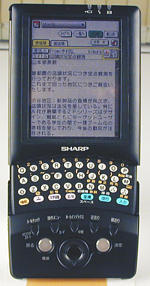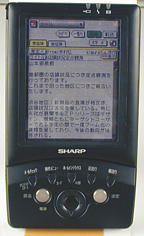

In a market flooding with similar featured PDAs, Sharp takes a bold leap, unveiling Linux/Java PDA at JavaOne.
At JavaOne in San Francisco, Sharp unveiled a new PDA for the non-Japan market that features an embedded Linux operating system and a Java application environment. Like many (perhaps most) recently announced PDAs and handheld computers, the device uses Intel's StrongARM system-on-chip processor as its core hardware platform. But unlike the makers of other mainstream PDAs, Sharp has clearly decided to gamble that a combo of Linux plus Java—rather than either Palm's highly popular Palm OS or Microsoft's struggling WinCE—will be key differentiators helping it to carve out a niche in the highly competitive PDA market.

Sharp's Linux/Java PDA with QWERTY Keyboard Exposed

Sharp's Linux/Java PDA with QWERTY Keyboard Concealed
Sharp Corporation, which claims to be the largest maker of handheld devices in Japan, has announced a goal of selling one million units of this new device worldwide by March 2002. In the words of Hiroshi Uno, general manager of Sharp's Mobile Systems Division: “we intend to aggressively combine Java with Sharp's user-interface technology and core devices, particularly LCDs, to develop powerful handheld products in wireless communication, data integration, multimedia and PIM-based applications.”
The devices are expected to be available late this year, hopefully in time for year-end holiday shoppers to make those geek-gottahave-gift purchases.
As of this writing, the precise name and model number of the new Sharp PDA was not available. However, sources within Sharp are referring to the new PDA as a member of the company's Zaurus PDA family. Sharp's Zaurus PDAs, while highly popular in Japan, have failed to catch on elsewhere, so this new Linux/Java PDA represents Sharp's attempt to succeed by carving out a Linux/Java PDA niche in the US, Europe and other worldwide markets.
The new Linux/Java PDA, a prototype of which was shown at JavaOne, sports a bright, full-color “quarter-VGA” LCD touch/display, along with a unique built-in QWERTY keyboard. The keyboard, which has small keys, is not something you'd want to do a lot of typing on. However, it certainly makes text entry straightforward.
Here's a summary of the unit's hardware specs:
206MHz StrongARM SA-1110 system-on-chip CPU
32MB DRAM, 16MB Flash (in the prototype, at least)
240 × 320 pixel (¼ VGA) full-color TFT LCD with touchscreen
QWERTY keyboard (behind sliding lower section)
CompactFlash and SecureDigital card slots
IrDA, serial, USB and audio I/O ports
One noteworthy feature of this new PDA is that the keyboard is hidden “inside” the lower portion of the PDA; the bottom section slides down to expose the keyboard. Thanks to this clever approach, the device has a typical PDA size when the keyboard is not in use. Also, the keys usually are not exposed to inadvertent presses.
On the software side, Lineo's Embedix was selected by Sharp as the new PDA's internal Linux OS, along with Tao's Intent JVM and ACCESS' Java-based NetFront browser. Additionally, Amiga has been selected to develop Java-based applications for the device, including things like games, animation and multimedia applications.
A key aspect of Sharp's strategy in adopting Linux/Java as the software environment for this new PDA is to create a vibrant developer community around the device. To encourage this, Sharp has launched a developer web site. Those who decide to register as developers (a quick and simple process) are immediately granted access to more detailed information about Sharp's new device and its associated developer program, including a FAQ about the device and the developer program, detailed specs of the device, discussion forums, information about development tools and documentation and application software and libraries (when available).
Whatever happened to the G.Mate's YOPY and Agenda's VR3 Linux PDAs? Both companies have ongoing beta-level products available for developers to play with, and both are scrambling to get their products ready for production.
Agenda is currently in an “any moment now” wait-loop, so their VR3 may well be shipping to customers by the time you read this. G.Mate hopes to have a fully released product shipping by November of this year and is obviously racing against Sharp to be the first to ship a high-end, Linux-based PDA. Also, MIZI Research is rumored to have formed a partnership with a major Korean electronics manufacturer, in an effort to bring out a Linux-based PDA/cell phone combo by the year's end.
At this rate, we could be facing an oversupply of Linux PDAs as we enter 2002!